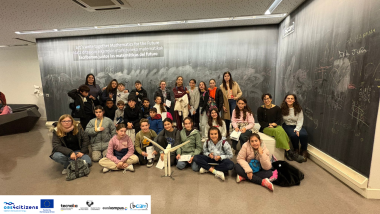The scientists who inspired us (VIII): Katherine Johnson
Scientists working in space programs have always inspired me, looking up to the sky, wondering how they could overcome the boundaries of our planet. This article is devoted to Katherine Johnson, an African-American mathematician at NASA that not only made possible the first crewed spaceflights. She also faced herself more limits here on earth: gender inequality and racial segregation that was established in the USA back to the ‘50s.
Creola Katherine Johnson (1918-2020) was born in White Sulphur Springs, West Virginia, USA. Her outstanding abilities were notorious at a young age as she started high school when she was only 10. At the age of 18, Johnson graduated from the historically black West Virginia State College with honors in mathematics and French and immediately started teaching at a black public school. Two years later, in 1939, she was handpicked, together with other two black students, to be the first ones to enroll at West Virginia University in a graduate program. After one semester studying math, she married and quit college to focus on her family.
It was 14 years later, in 1953, when Johnson got a position at the National Advisory Committee for Aeronautics (NACA), more precisely, at the Langley Memorial Aeronautical Laboratory in Hampton, Virginia. For five years (1953-1958), she worked as a “computer” performing complex calculations by hand. She first worked within a group of African-American women known as “west computers” until she got reassigned to the Flight Research Division. In 1958, NACA became part of the National Aeronautics and Space Administration (NASA), which introduced digital computers. She worked as an aerospace technologist at NASA until her retirement in 1986, collaborating in the space shuttle program, among many other projects.
Johnson played an essential role in different space programs. In 1961, she calculated the trajectory for Alan Shepard in the spacecraft called Freedom 7. He was the first American astronaut to travel into space. In 1962, astronaut John Glenn refused to fly in the Friendship 7 until Johnson personally verified the calculations an IBM computer performed for his path. The victorious story of Glenn being the first US astronaut orbiting the earth, made a saddle point in the space race against the soviets. In 1969, Johnson took part in the Appollo 11 mission studying launch locations that allowed the first spaceflight landing three humans in the moon.
During her years in Langley, she had to work in a segregated environment. In the premises, colored personnel were forced to use separate bathrooms and dining facilities concerning their white peers. Moreover, at NASA, women were not allowed to attend official meetings or owned scientific reports even if they were working in the programs. Nevertheless, Johnson achieved to co-authored a research report in 1960, being then the first time in the history of her division a woman received such recognition. She published 26 articles in her entire career.
Katherine Johnson passed away on February this year at the age of 101. She dedicated the last decades of her life to inspire young generations to enter the fields of science, technology, engineering, and mathematics (STEM). The society has also given her back the undoubted recognition she deserved. In 2015, she received the honorable Presidential Medal of Freedom from President Barack Obama. In 2016, NASA named a new building after her: the Katherine G. Johnson Computational Research Facility. In the same year, the author Margot Lee Shetterly published the book called Hidden Figures about the story of Katherine Johnson, and two other NASA scientists at that time: Dorothy Vaughan and Mary Jackson. The acclaimed film about the book was also released in 2016.
I consider Katherine a pioneer and a role model. Her fascinating story reveals that her passion for mathematics was much stronger than the hostility and cruelty of a segregated country.
Related news
BCAM people
Former BCAM PhD Student Peter Angerman Wins British Society of Rheology Vernon Harrison Award
Women in Science




